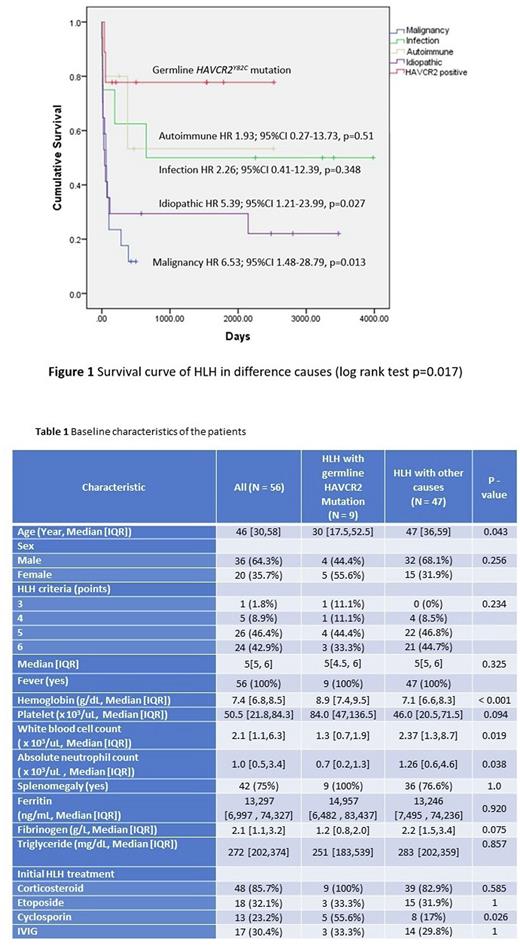Abstract
Hemophagocytic lymphohistiocytosis (HLH) is a potentially fatal condition caused by excessive immune activation. Known etiologies are malignancies, infections, and autoimmune diseases. Subcutaneous panniculitis-like T-cell lymphoma (SPTCL) is associated with HLH in approximately 15-20% of cases. Recent studies identified germline HAVCR2 (Hepatitis A Virus-Cellular Receptor 2) mutations in SPTCL and/or HLH. The most commonly reported mutation is HAVCR2 p.Y82C. We aimed to explore the incidence of germline HAVCR2Y82C mutation in SPTCL-associated and idiopathic HLH and compare clinical outcomes with HLH from other causes.
We collected patients, aged 15 or older, with HLH or HLH-like systemic illness from January 2011 to June 2022. HLH was defined according to the HLH-2004 criteria. The term HLH-like systemic illness was applied to those with incomplete HLH-2004 criteria, but clinically consistent with HLH. Causes of HLH were comprehensively reviewed and documented for baseline characteristics. Direct sequencing to detect germline HAVCR2 p.Y82C (c.245A>G) was done in idiopathic and SPTCTL-associated HLH. DNA was extracted from formalin-fixed paraffin-embedded specimens or blood samples.
Of the 56 HLH or HLH-liked patients, 64% were male with the median age of 46 years old. The median HLH-2004 diagnostic score was 5 (26/56; 46.4%), ranging from 3 - 6 points. We detected germline HAVCR2Y82C mutations in 9 out of 56 cases (16%), of which 5 cases diagnosed with SPTCL, while 4 cases were idiopathic HLH. Six of 9 mutated cases carried homozygous HAVCR2Y82C mutation. The other causes of HLH were hematologic malignancies excluding SPTCL (17/56; 30%), idiopathic HLH without HAVCR2 mutation (17/56; 30%), infections (8/56, 14.3%) and autoimmune diseases (5/56; 8.9%). The hematologic malignancy subgroup comprised NK/T cell lymphoma (5/17; 30% ), diffuse large B-cell lymphoma (3/17; 17%), peripheral T-cell lymphoma, not otherwise specified (3/17; 17%), pure erythroid leukemia (2/17; 12%), non-Hodgkin's lymphoma unknown type (2/17; 12%), Hodgkin's lymphoma (1/17; 6%) and myelodysplastic neoplasms (1/17; 6%).
Patients with germline HAVCR2Y82C mutations showed superior survival than the others (Figure 1). Idiopathic and malignancy-associated HLH showed significant inferior outcomes compared to patients with germline HAVCR2 mutations with hazard ratios (HR) of 5.39 (95% Confidence interval [CI] 1.21-23.99; p=0.027) and 6.53 (95%CI 1.48-28.79; p=0.013), respectively. HLH with germline HAVCR2Y82C mutation were younger than HLH from other causes (30 vs. 47 years old; p=0.043). Patients with germline HAVCR2Y82C mutations showed significantly higher hemoglobin levels but lower absolute neutrophil count than HLH with other causes (Table 1).
In conclusion, germline HAVCR2 mutations define a subgroup of HLH with better survival than the others. The mutation test is helpful to determine the prognosis of HLH.
Disclosures
No relevant conflicts of interest to declare.
Author notes
Asterisk with author names denotes non-ASH members.


This feature is available to Subscribers Only
Sign In or Create an Account Close Modal